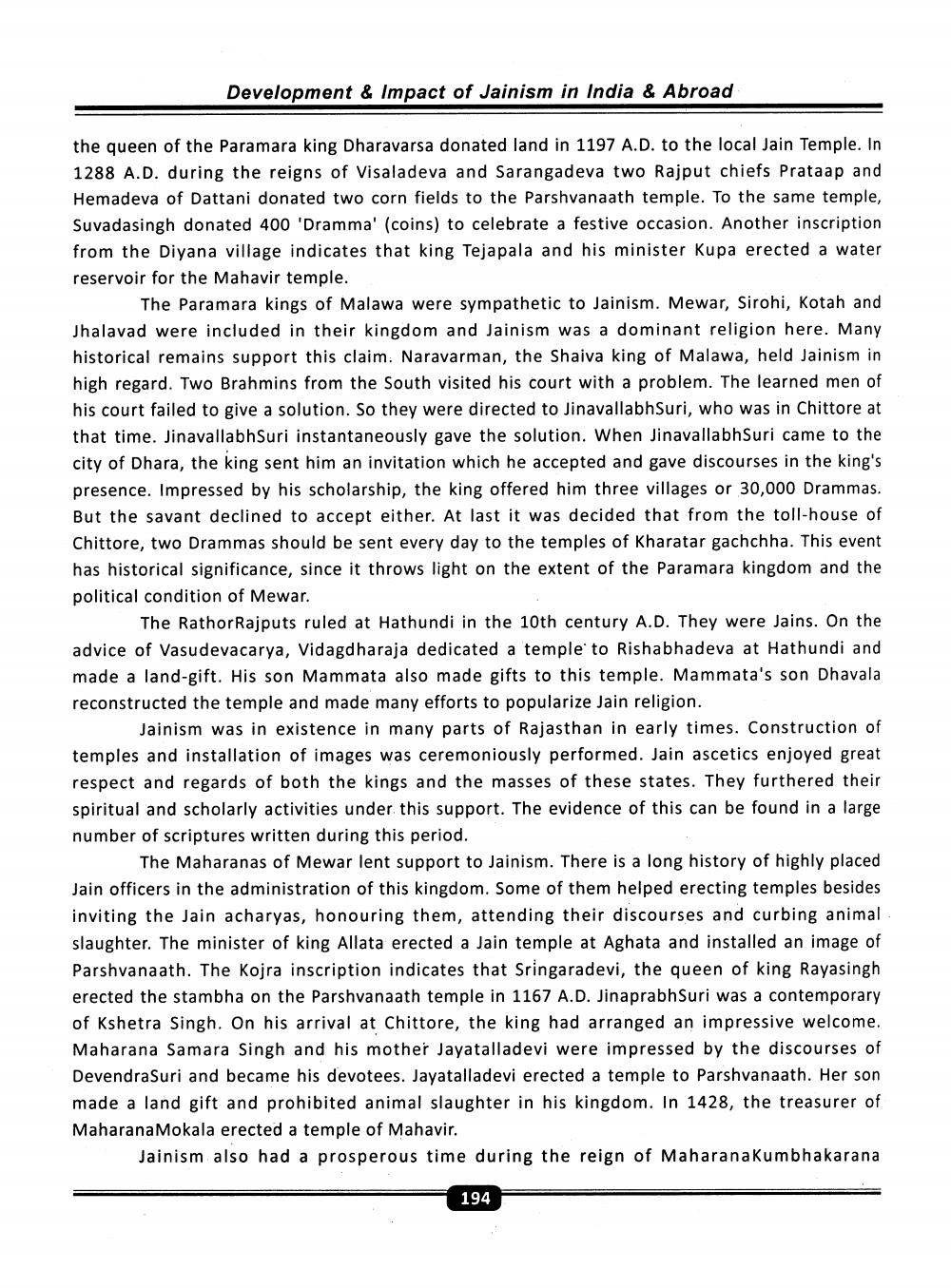________________
Development & Impact of Jainism in India & Abroad
the queen of the Paramara king Dharavarsa donated land in 1197 A.D. to the local Jain Temple. In 1288 A.D. during the reigns of Visaladeva and Sarangadeva two Rajput chiefs Prataap and Hemadeva of Dattani donated two corn fields to the Parshvanaath temple. To the same temple, Suvadasingh donated 400 'Dramma' (coins) to celebrate a festive occasion. Another inscription from the Diyana village indicates that king Tejapala and his minister Kupa erected a water reservoir for the Mahavir temple.
The Paramara kings of Malawa were sympathetic to Jainism. Mewar, Sirohi, Kotah and Jhalavad were included in their kingdom and Jainism was a dominant religion here. Many historical remains support this claim. Naravarman, the Shaiva king of Malawa, held Jainism in high regard. Two Brahmins from the South visited his court with a problem. The learned men of his court failed to give a solution. So they were directed to JinavallabhSuri, who was in Chittore at that time. JinavallabhSuri instantaneously gave the solution. When JinavallabhSuri came to the city of Dhara, the king sent him an invitation which he accepted and gave discourses in the king's presence. Impressed by his scholarship, the king offered him three villages or 30,000 Drammas. But the savant declined to accept either. At last it was decided that from the toll-house of Chittore, two Drammas should be sent every day to the temples of Kharatar gachchha. This event has historical significance, since it throws light on the extent of the Paramara kingdom and the political condition of Mewar.
The Rathor Rajputs ruled at Hathundi in the 10th century A.D. They were Jains. On the advice of Vasudevacarya, Vidagdharaja dedicated a temple' to Rishabhadeva at Hathundi and made a land-gift. His son Mammata also made gifts to this temple. Mammata's son Dhavala reconstructed the temple and made many efforts to popularize Jain religion.
Jainism was in existence in many parts of Rajasthan in early times. Construction of temples and installation of images was ceremoniously performed. Jain ascetics enjoyed great respect and regards of both the kings and the masses of these states. They furthered their spiritual and scholarly activities under this support. The evidence of this can be found in a large number of scriptures written during this period.
The Maharanas of Mewar lent support to Jainism. There is a long history of highly placed Jain officers in the administration of this kingdom. Some of them helped erecting temples besides inviting the Jain acharyas, honouring them, attending their discourses and curbing animal slaughter. The minister of king Allata erected a Jain temple at Aghata and installed an image of Parshvanaath. The Kojra inscription indicates that Sringaradevi, the queen of king Rayasingh erected the stambha on the Parshvanaath temple in 1167 A.D. JinaprabhSuri was a contemporary of Kshetra Singh. On his arrival at Chittore, the king had arranged an impressive welcome. Maharana Samara Singh and his mother Jayatalladevi were impressed by the discourses of DevendraSuri and became his devotees. Jayatalladevi erected a temple to Parshvanaath. Her son made a land gift and prohibited animal slaughter in his kingdom. In 1428, the treasurer of Maharana Mokala erected a temple of Mahavir.
Jainism also had a prosperous time during the reign of Maharana Kumbhakarana
194




